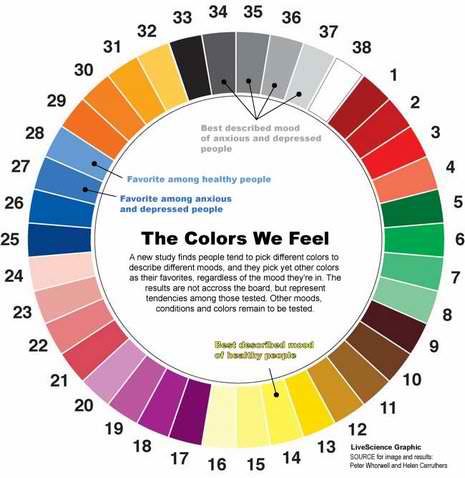The colors you use to represent your business can often have a great impact on how people ‘see‘ your business. We’ve all learned, at some point, the basics of color psychology but when’s the last time you used this with your business. Sometimes people will even get pumped about using color psychology for their logo but forget that it does impact all parts of their business…like you business cards or your advertisements.
When you write your business plan or even your mission statement you state what your business represents and what your purpose is. What I believe you should do is set your ‘Color Mission Statement.’ Just as you would do with a mission statement you should set out (and set up) what colors represent your business in the right light. Below I’ve included some simple, and some not so simple, resources and descriptions of what colors should represent your business. Most of the websites referenced below also disclaim that different colors mean different things to different cultures and these relate to North American culture.
The Basics Of Color
The following are the basics of color psychology taken from InfoPlease. It’s a lot of what you might have learned in a Intro To Marketing class or something like that. Just like anything, we’ll touch on the basics and then go a little deeper down the rabbit hole.
Black
Black is the color of authority and power. It is popular in fashion because it makes people appear thinner. It is also stylish and timeless. Black also implies submission. Priests wear black to signify submission to God. Some fashion experts say a woman wearing black implies submission to men. Black outfits can also be overpowering, or make the wearer seem aloof or evil. Villains, such as Dracula, often wear black.
White
Brides wear white to symbolize innocence and purity. White reflects light and is considered a summer color. White is popular in decorating and in fashion because it is light, neutral, and goes with everything. However, white shows dirt and is therefore more difficult to keep clean than other colors. Doctors and nurses wear white to imply sterility.
Red
The most emotionally intense color, red stimulates a faster heartbeat and breathing. It is also the color of love. Red clothing gets noticed and makes the wearer appear heavier. Since it is an extreme color, red clothing might not help people in negotiations or confrontations. Red cars are popular targets for thieves. In decorating, red is usually used as an accent. Decorators say that red furniture should be perfect since it will attract attention.
The most romantic color, pink, is more tranquilizing. Sports teams sometimes paint the locker rooms used by opposing teams bright pink so their opponents will lose energy.
Blue
The color of the sky and the ocean, blue is one of the most popular colors. It causes the opposite reaction as red. Peaceful, tranquil blue causes the body to produce calming chemicals, so it is often used in bedrooms. Blue can also be cold and depressing. Fashion consultants recommend wearing blue to job interviews because it symbolizes loyalty. People are more productive in blue rooms. Studies show weightlifters are able to handle heavier weights in blue gyms.
Green
Currently the most popular decorating color, green symbolizes nature. It is the easiest color on the eye and can improve vision. It is a calming, refreshing color. People waiting to appear on TV sit in “green rooms” to relax. Hospitals often use green because it relaxes patients. Brides in the Middle Ages wore green to symbolize fertility. Dark green is masculine, conservative, and implies wealth. However, seamstresses often refuse to use green thread on the eve of a fashion show for fear it will bring bad luck.
Yellow
Cheerful sunny yellow is an attention getter. While it is considered an optimistic color, people lose their tempers more often in yellow rooms, and babies will cry more. It is the most difficult color for the eye to take in, so it can be overpowering if overused. Yellow enhances concentration, hence its use for legal pads. It also speeds metabolism.
Purple
The color of royalty, purple connotes luxury, wealth, and sophistication. It is also feminine and romantic. However, because it is rare in nature, purple can appear artificial.
Brown
Solid, reliable brown is the color of earth and is abundant in nature. Light brown implies genuineness while dark brown is similar to wood or leather. Brown can also be sad and wistful. Men are more apt to say brown is one of their favorite colors.
Read more: Color Psychology — Infoplease.com http://www.infoplease.com/spot/colors1.html#ixzz2GGQp8UQA
Down The Rabbit Hole:
You may have just ‘breezed’ through that first part, but here’s a little more food for thought. I was browsing on Branding Strategy Insider when I found a little more advanced color wheel for your palette (pun intended.)

Here are some other adjectives (from BSI) that describe colors:
Red — excitement, strength, sex, passion, speed, danger.
Blue — (listed as the most popular color) trust, reliability, belonging, coolness.
Yellow — warmth, sunshine, cheer, happiness
Orange — playfulness, warmth, vibrant
Green — nature, fresh, cool, growth, abundance
Purple — royal, spirituality, dignity
Pink — soft, sweet, nurture, security
White — pure, virginal, clean, youthful, mild.
Black — sophistication, elegant, seductive, mystery
Gold — prestige, expensive
Silver — prestige, cold, scientific
I thought that BSI did a really good job of ‘fine tuning’ color psychology, like telling you what ‘shade’ of blue that ‘healthier’ people preferred. I’d recommend reading the full article.
Even Deeper Down The Rabbit Hole:
If you’d like to go even deeper down the rabbit whole you can get into the real psychology of colors. Here’s an introductory video on the subject:
Links in the video include ColourLovers and Color Scheme Designer.
In Conclusion:
I think that’s about it for now. Maybe one day soon we’ll get into a little more ‘advanced’ post about colors. Basically the purpose of colors is to visually represent your business and it’s important…as important as your mission statement. Make sure you think about how you want your business to be represented. You can learn the color theory behind it or let I Heart Blank help you out.

